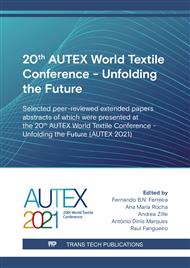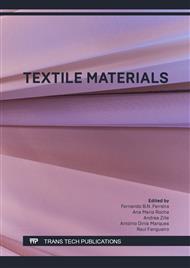[1]
H. Amid, A. A. A. Jeddi, M. Salehi, H. Dabiryan, R. Pejman, Investigation of circular woven composite pipes, AUTEX Res. J. 16 (2016) 100-108.
DOI: 10.1515/aut-2015-0036
Google Scholar
[2]
K. Otsuka, C. M. Wayman, Shape memory materials, first ed., Cambridge University Press, Cambridge (1999).
Google Scholar
[3]
A. Lai, Z. Du, C. L. Gan, C. A. Schuh, Shape memory and superelastic ceramics at small scales, Science 341 (2013) 1505–8.
DOI: 10.1126/science.1239745
Google Scholar
[4]
X. Feng, G. Zhang, S. Zhuo, H. Jiang, J. Shi, F. Li, Dual responsive shape memory polymer/clay nanocomposites, Compos. Sci. Technol. 129 (2016) 53–60.
DOI: 10.1016/j.compscitech.2016.04.008
Google Scholar
[5]
P. K. Kumar, C. Caer, G. Atkinson, E. Patoor, D. C. Lagoudas. The influence of stress and temperature on the residual strain generated during pseudoelastic cycling of NiTi SMA wires, Proc. SPIE 7978, Behavior and Mechanics of Multifunctional Materials and Composites 2011, 79781E (27 April 2011).
DOI: 10.1117/12.881994
Google Scholar
[6]
J. M. Jani, M. Leary, A. Subic, M. A. Gibson, A review of shape memory alloy research, applications and opportunities, Mater. Des. 56 (2014) 1078–113.
DOI: 10.1016/j.matdes.2013.11.084
Google Scholar
[7]
V. Michaud, Can shape memory alloy composites be smart?, Scr. Mater. 50 (2004) 249-53.
Google Scholar
[8]
P. Bettini, M. Riva, G. Sala, L. D. Landro, A. Airoldi, J. Cucco, Carbon Fiber Reinforced Smart Laminates with Embedded SMA Actuators—Part I: Embedding Techniques and Interface Analysis, J. Mater. Eng. Perform. 18 (2009) 664–71.
DOI: 10.1007/s11665-009-9384-z
Google Scholar
[9]
F. Boussu, G. Bailleul, Development of shape mempry alloy fabrics for composite structures. AUTEX Res. J. 2 (2002) 1–7.
Google Scholar
[10]
A. Sofla, S. A. Meguid, K. T. Tan, W. K. Yeo, Shape morphing of aircraft wing: Status and challenges, Mater. Des. 31 (2010) 1284–1292.
DOI: 10.1016/j.matdes.2009.09.011
Google Scholar
[11]
M. Ashir, A. Nocke, C. Cherif, Development of shape memory alloy hybrid yarns for adaptive fiber-reinforced plastics, Text. Res. J. 89 (2019) 1371–1380.
DOI: 10.1177/0040517518770678
Google Scholar
[12]
M. Ashir, J. Hindahl, A. Nocke, C. Sennewald, C. Cherif, Development of adaptive pleated woven fabrics with shape memory alloys, Text. Res. J. 89 (2019) 2330–2341.
DOI: 10.1177/0040517518792736
Google Scholar
[13]
M. Ashir, J. Hindahl, A. Nocke, C. Cherif, A statistical approach for the fabrication of adaptive pleated fiber reinforced plastics, Compos. Struct. 207 (2019) 537–545.
DOI: 10.1016/j.compstruct.2018.09.061
Google Scholar
[14]
M. Ashir, M. Vorhof, A. Nocke, Influence of thickness ratio and integrated weft yarn column numbers in shape memory alloys on the deformation behavior of adaptive fiber-reinforced plastics, Compos. Struct. 215 (2019) 493–501.
DOI: 10.1016/j.compstruct.2019.02.081
Google Scholar
[15]
M. Ashir, A. Nocke, U. Hanke, C. Cherif, Adaptive hinged fiber reinforced plastics with tailored shape memory alloy hybrid yarn, Polym. Compos. 41 (2020) 191-200.
DOI: 10.1002/pc.25359
Google Scholar
[16]
M. Ashir, Activation time-and electrical power-dependent deformation behavior of adaptive fiber-reinforced plastics, J. Compos. Mater. 53 (20) 2777-2788.
DOI: 10.1177/0021998319839457
Google Scholar
[17]
M. Ashir, J. Hindahl, A. Nocke, C. Cherif, Development of an adaptive morphing wing based on fiber-reinforced plastics and shape memory alloys, J. Ind. Text. 50 (2020), 114-129.
DOI: 10.1177/1528083718823295
Google Scholar
[18]
M. Ashir, A. Nocke, C. Cherif, Maximum deformation of shape memory alloy based adaptive fiber-reinforced plastics, Compos. Sci. Technol. 184 (2019) 107860.
DOI: 10.1016/j.compscitech.2019.107860
Google Scholar
[19]
M. Ashir, C. Cherif, Development of shape memory alloy based adaptive fiber-reinforced plastics by means of open reed weaving technology, J. Reinf. Plast. Compos. 39 (2020) 563–571.
DOI: 10.1177/0731684420920941
Google Scholar
[20]
M. Ashir, A. Nocke, C. Cherif, Adaptive fiber-reinforced plastics based on open reed weaving and tailored fiber placement technology, Text. Res. J. 90 (2020) 981–990.
DOI: 10.1177/0040517519884578
Google Scholar



